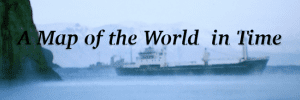
Award-winning Writer/Director/Producer of eleven feature fiction and documentary films and Assistant Professor at the Nicholson School of Communication and Media, Georg Koszulinski is working on a documentary this summer. A Map of the World in Time seeks to make a significant contribution to the documentary history of oceanography while also exploring universal themes of endurance and the quest for knowledge, as the BADEX scientists work in unison to better understand anthropogenic climate change. While production is set to start in June at the Columbia University Lamont Doherty Earth Observatory, I had the opportunity to ask Koszulinksi a few questions regarding the documentary.
- What is this documentary about?
“A Map of the World in Time is at once an investigation into climate change, and a portrait of a community with a shared mission. The film aims to create a portrait of the scientists and the crew alike, exploring both the critical need for the scientific work and the personal trials and tribulations of a group of individuals working together to better understand climate change and the Earth’s history.”
- When and where can people watch it?
“It should be completed by 2024 and after a film festival run will hopefully find national and international distribution.”
- What inspired you to make this documentary?
“This work comes as a continuation of my Anthropocene Cycle of short films, where I explore the social, political, and ecological realities of anthropogenic climate change. Also, my last film was a fictional cross-generational portrait of scientists trying to make sense of their world. A Map of the World in Time is a real-life exploration of similar questions and themes.”
- What are your favorite parts about creating films?
“I enjoy many aspects of filmmaking—more than I can account for in a short answer. I love the critical and creative engagement that is required of the process. There is a critical engagement with the external world and the history of ideas. There is creative engagement on so many levels, from early ideation, writing, and previsualization to directorial and cinematographic approaches, and then the creative process that is the editing. As an artisanal filmmaker I’m hands-on with all of these roles and more, and greatly enjoy the challenges and opportunities of the process.”
- Do you have any advice for any young filmmakers?
“I’ll suggest some of what I’ve done and maybe some of this will work for others: Rigorously and systematically study the history of cinema, and not just fictional narrative, but documentary and experimental film as well. Seek out rare and interesting work, not just in film but across art forms like literature, music, visual art, among others. Keep notes. Collaborate with others. Find a community of likeminded creators and work with them. Filmmaking even at the most artisanal level is inherently collaborative. Also, always be writing, always be filming, with whatever camera you have access to. The specific camera is not important—your ideas are important, and how you articulate them through audio-visual means. The camera can also serve as a kind of journal. It can also be a tool for self-exploration. You can develop your directorial style and vision through a process of continual creation and exploration. Also, many of the film students in this program are making films in student clubs, which I think is brilliant. Join one of these clubs!”
Check out the details about A Map of the World in Time here: https://badexfilm.com/
By Majdulina Hamed.
Published to Nicholson News on June 1st, 2023.
If you have any news, accomplishments or highlights about your work or life, please be sure to share them with us, by emailing us at NicholsonNews@ucf.edu.